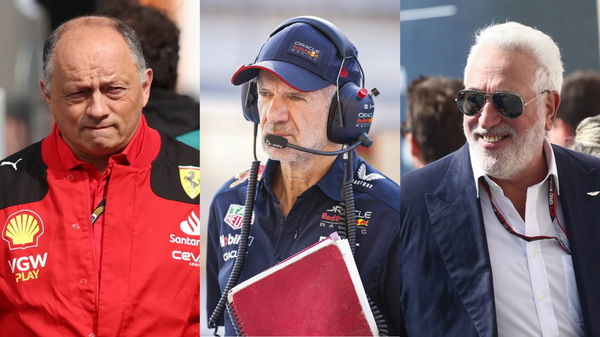Toto Wolff Arms Lewis Hamilton With $150,000 Weapon to Atone for Past Blunder

Follow Us

via Imago
Image Courtesy : Imago L: Toto Wolff R: Lewis Hamilton
In a decisive move to overcome recent blunders, Toto Wolff, the man at the helm of Mercedes’ Formula 1 operation, has orchestrated significant changes to Lewis Hamilton‘s racing machine. With a concentrated focus on the W14’s aerodynamics and a significant budget injection, the Mercedes car is poised to rebound from a challenging phase. As Toto Wolff arms Lewis Hamilton with this $150,000 weapon, he is not merely seeking atonement for past blunders – he is sculpting the future of Mercedes in Formula 1.
Central to this strategy has been the overhaul of the ‘zero pods’, a design element that had demonstrated considerable drawbacks in the intense battle of Formula 1 racing. From the outset, the ‘zero pod’ concept had proven to be Mercedes‘ Achilles’ heel this year. These decisions, though seemingly compromises, should be viewed as calculated experiments. They serve not only as corrective measures for the present W14 but also as formative blueprints for the aerodynamics of the next-generation single-seater.

via Reuters
Formula One F1 – Spanish Grand Prix – Circuit de Barcelona-Catalunya, Barcelona, Spain – June 2, 2023 Mercedes’ Lewis Hamilton during practice REUTERS/Nacho Doce
Prior to the Monaco GP, the W14 suffered due to its aerodynamic design, with these issues rooted heavily in the concept of ‘zero pods’. Not only did this have an adverse effect on the downforce, but it also destabilized the car’s overall balance. Given this, a critical decision was taken – to redesign the aerodynamic concept, taking cues from Red Bull’s sloping sides design. Engineers, under the leadership of Mike Elliott and later James Allison, orchestrated an integration between the revised aerodynamics and the dynamics of the single-seater, particularly the suspensions.
ADVERTISEMENT
Article continues below this ad
As per Gazzetta, a notable aspect of this overhaul was a significant change to the front suspension, where the front attachment point of the upper triangle was raised relative to the early season version. Costing somewhere in the range of $150,000, this revised suspension focused on enhancing the “anti-dive” feature, which helps manage changes in the car’s height from the ground. The car’s chassis was mostly unchanged, except for the upper front corner.
In the ever-evolving battlefield of Formula 1, Mercedes, under Wolff’s stewardship, is displaying a blend of humility and audacity – learning from its own history, borrowing from its competitors, and innovating for a future where the Silver Arrows aim to soar once more.
Can Lewis Hamilton turn the tide with W14 changes: A retrospective on F1 teams’ mid-season changes
ADVERTISEMENT
Article continues below this ad
Formula 1 is a world where innovation and adaptation are as crucial as speed. Although Mid-season changes are risky but can bring transformative success. Here’s a look at some memorable instances: In 1974, Ferrari was grappling with the underperforming 312B3 model. Niki Lauda, driving for Ferrari, demanded better. The response was the 312B3-74, a significant overhaul of the original model. This brave pivot yielded results; Lauda clinched two race wins and ranked fourth in the driver’s standings, propelling Ferrari to second in the constructors’ standings.

via Reuters
Formula One F1 – Hungarian Grand Prix – Hungaroring, Budapest, Hungary – July 23, 2023 Red Bull’s Max Verstappen leads Mercedes’ Lewis Hamilton at the start of the race REUTERS/Bernadett Szabo
McLaren in 1984 already had a competitive car, the MP4/2, powered by a Porsche engine. Seeking an edge, the team made extensive aerodynamic changes, including a redesigned rear wing. The outcome was a fairy-tale finish: Niki Lauda seized the drivers’ championship by half a point over teammate Alain Prost, and McLaren secured the constructors’ title.
ADVERTISEMENT
Article continues below this ad
Trending

Lando Norris Faces Brutal Injury After Party With Martin Garrix Goes Wrong Ahead of Miami GP
April 27, 2024 07:33 PM EDT

Miami GP Organisers Threaten to Revoke Donald Trump’s $250,000 Proposition for the Miami International Autodrome
April 27, 2024 04:47 PM EDT

Liam Lawson’s Surprise Contract Clause Threatens Daniel Ricciardo’s RB Seat
April 24, 2024 11:15 AM EDT

Adrian Newey’s “Personal Issue” With Christian Horner the Reason Behind Red Bull Mastermind’s Exit
April 27, 2024 10:51 AM EDT

F1 Rumor: Lawrence Stroll Offers Adrian Newey $100 Million to Poach Him From Frederic Vasseur and Co’s Interest
April 26, 2024 03:16 PM EDT
Get instantly notified of the hottest F1 stories via Google! Click on Follow Us and Tap the Blue Star.

Follow Us
In 2013, Mercedes was fast but plagued by tire wear issues. Comprehensive changes to the car’s setup and strategy revolutionized their season. Lewis Hamilton and Nico Rosberg collectively claimed three wins in the season’s latter half.
These instances underline the potent impact mid-season changes can have. They’re a gamble, risking team rhythm and requiring adaptation. However, when executed with precision, these changes can dramatically improve performance and potentially rewrite championship narratives in Formula 1’s relentless quest for victory.
WATCH THIS STORY | Sir Lewis Hamilton fanboys over Zendaya and cheekily tries to land Euphoria role at Paris Fashion Week
Edited by:

Aishwary Gaonkar

